Pond Stocking
At Florida Lake & Pond Care llc. we encourage the use of native species in recreational ponds whenever possible. A pond stocked with healthy bass, bluegills and red ear sunfish (shell crackers) will yield many years of enjoyment.
Typically, new ponds in Florida greater than ½ acre in area are stocked with 500 mixed bluegill and red ear sunfish and 100 to 150 Florida large-mouth bass per acre. Channel catfish may also be stocked at 100 to 300 fingerlings per acre in combination with other fish or at up to 2000 per acre when stocked alone. Ponds less than ½ acre are generally more successful when stocked with catfish only. Although game fish will survive in smaller bodies of water, it is difficult to maintain a proper ratio of predator and forage fish. If predatory fish are stocked we recommend lake owners practice catch and release in their small pond because the removal of relatively few fish can lead to an imbalance resulting in the stunting of fish and a general decline in the health of the pond.
There is considerable confusion regarding the species of pan fish used
for stocking. Below you will find a photo of a red ear sunfish.
Please note the red margin of the opecular lobe of the gill cover.
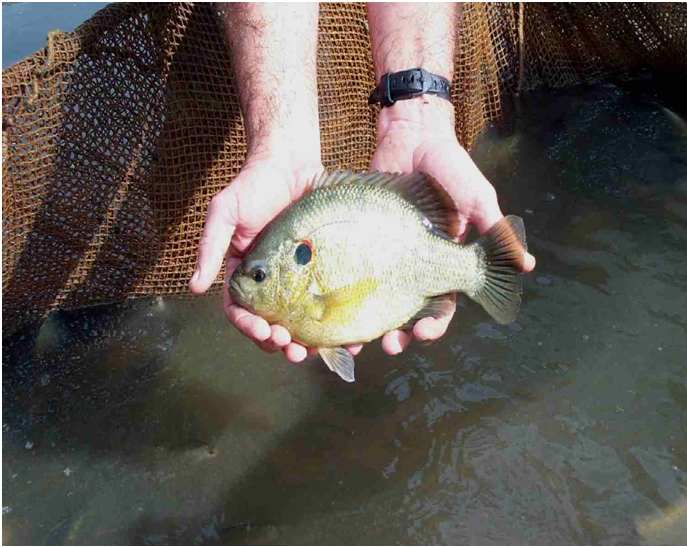
Another misconception is that there is a separate species of sunfish
known as the copper nose. In actuality, the copper nose (or copperhead, as
it is sometimes called), is the male Florida strain bluegill. Note the
copper colored banding which gives the male its nickname.
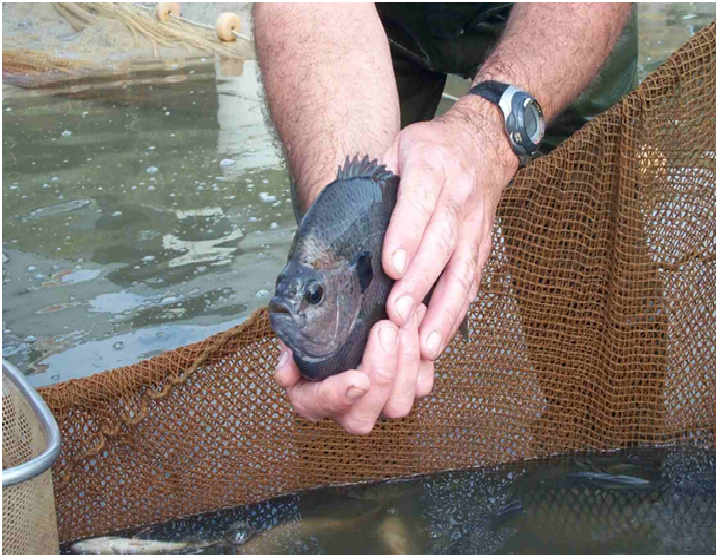
Except for the lack of red markings on the opecular lobe, the female
bluegill might be mistaken for the red ear sunfish. The female bluegill
(left) and male bluegill (right) are depicted below.
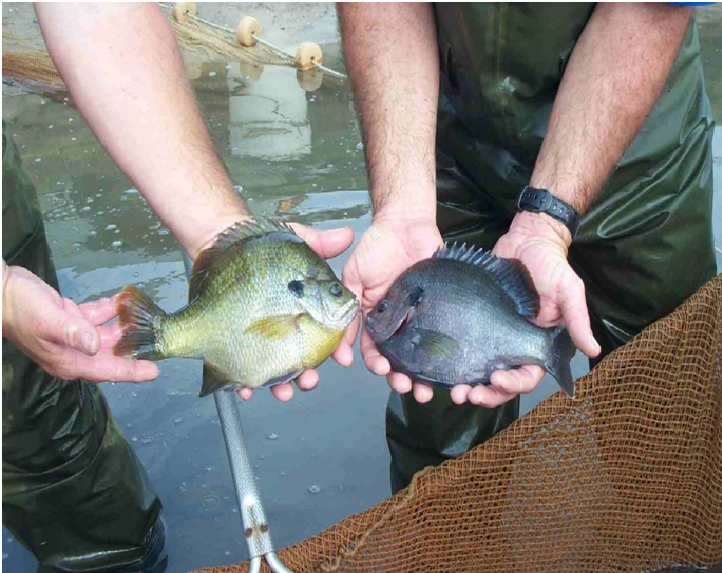
Channel Catfish
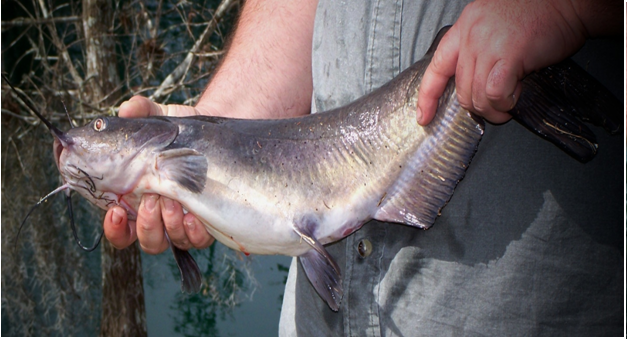
1.5 years in nutritionaly supplamented ponds (above) 1 month old (below)
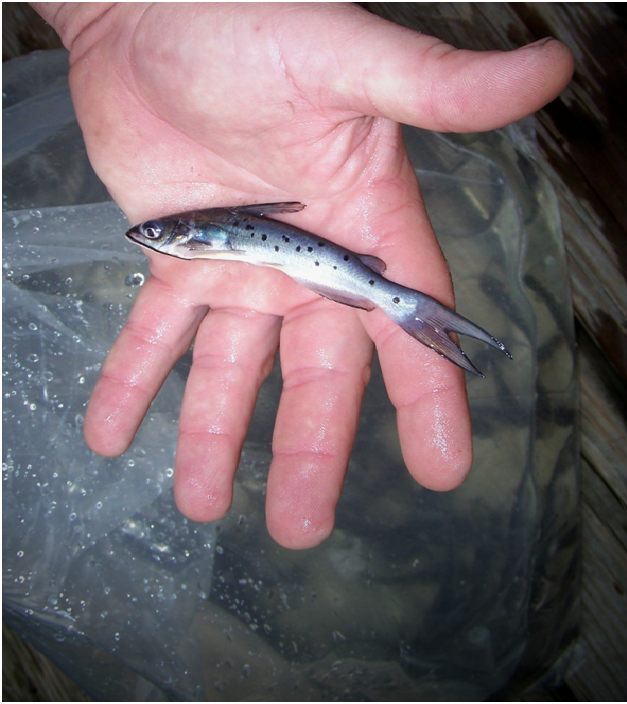
The Channel Catfish are one of the easiest fish to manage in your pond. They can feed on a live forage or you can supplement with a commercial feed. Supplemental feeding will often allow the catfish to achieve growth rates sometimes exceeding 1 1/2 pounds per season. When feeding a commercial feed on a regular basis, their meat will be as clean, white, and as well marbled as any fish in the pond. Many people consider a commercial fed catfish to have a table quality second to none! Another advantage to commercial feeding a Channel Catfish is that they will feed on top of the water allowing people of all ages to enjoy the fish even more.
It is not unusual for channel catfish to attain weights of 5 pounds or more in a well fed pond.
These fish can be stocked independently or as part of a combination stocking with Large-mouth Bass, Hybrid Bluegill, and Black Crappie. When stocked properly the Channel Catfish will not have any negative effects on reproduction or growth rates of the other fish in your pond.
The Large-mouth Bass:
Is the most highly pursued game fish in North America.
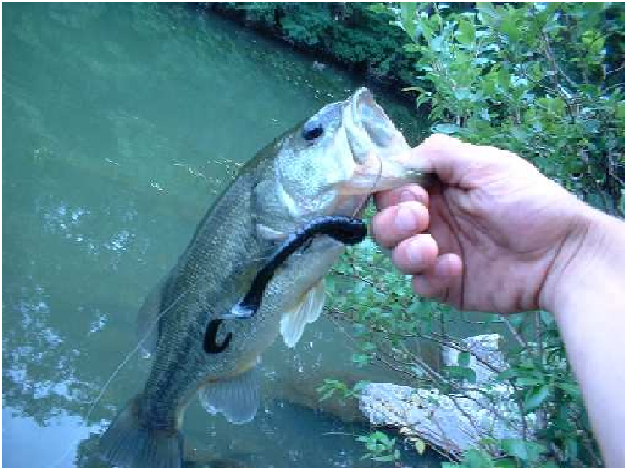
Found in all types of fresh water, from small farm ponds to the largest of lakes, from small irrigation ditches to large rivers and streams,
Large-mouth Bass
can also be caught under many varying types of water conditions, from the very warm water of summer to the frozen iced over lakes in the winter.
The Large-mouth Bass
is probably one of the most exciting fresh water fish to catch, from the little slow tug on your line through the ice, to the exploding water around your top water plug. The Large-mouth is a thrill a second!
The Large-mouth Bass
is also highly regarded around the dinner table. Although some people would try to make you think differently, it doesn't take a fancy bass boat or expensive gear, to enjoy the thrill of catching this remarkable fish! Yep believe it or not the ole basics (cane pole and worm) are still very effective.
The Large-mouth Bass
has a very wide range on its appetite selections. It can be caught on red worms, leaf worms, night crawlers, leeches, bee moth, crayfish, minnows, and all types of artificial baits, from top water lures to under water spinners and spoons. And believe it or not I've even seen nice bass caught on catfish stink bait.
Feeding Habits of the Large-mouth Bass:
The newly hatched large-mouth bass
feed heavily on tiny crustaceans and other zoo-plankton until the bass reach 2 inches in length. Then their appetite changes to insects and smaller fish. The adult bass's diet consists mainly of fish, but crayfish, worms, frogs, and insects are important foods in some waters.
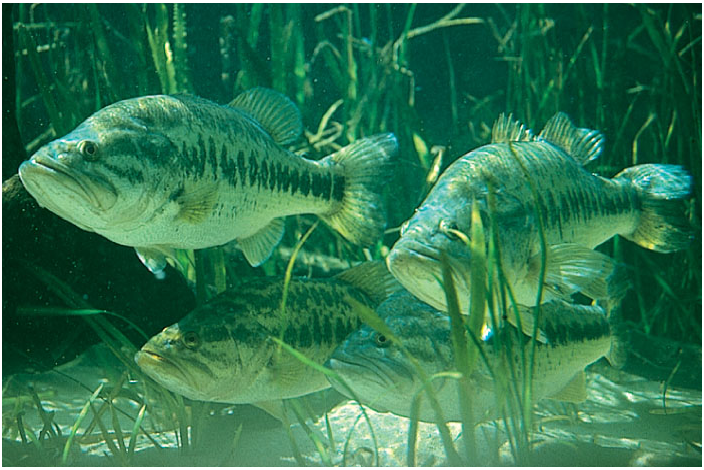
Large-mouth Bass Spawning Habits:
The Large-mouth Bass
gets ready to spawn in the spring, when the inshore water temperature reaches about 60 f
Bass fish eggs
hatch in only 2 days if the water temp is at 72 degrees, but take 5 days at 67 degrees. From 2000 to 12,000 eggs hatch from the typical nest, and of all these only 5 - 10 are likely to survive to reach 10 inches in length. The male will then guard and protect the fry until they reach about an inch in length and then abandon them.. And after this point he will also eat any fry he encounters.
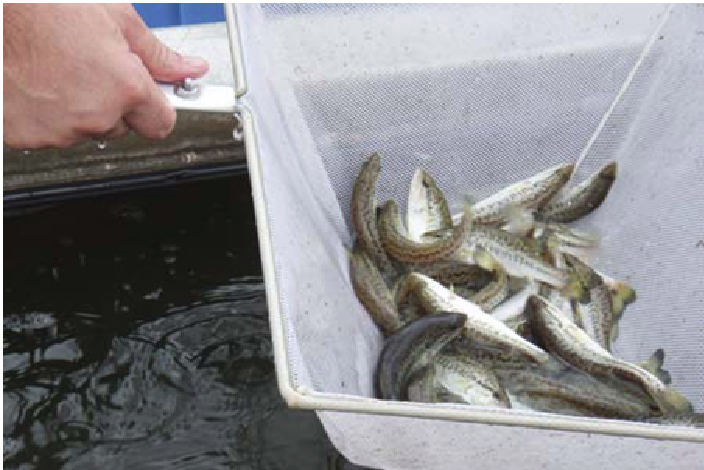
Triploid Grass Carp

(3-5 inch above)
2 years below
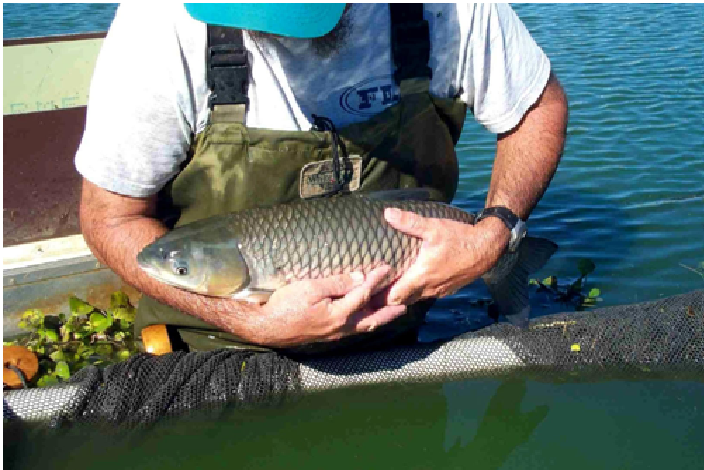
Feeding
Habits: As the name implies grass carp consume higher aquatic
plants and submerged grasses (rooted macrophytes as opposed to algaes); they
will also eat detritus, insects and other invertebrates when necessary. Because
of their feeding behavior, they are used in this country under special
restricted circumstances to help manage aquatic plant problems. Many aquatic
plants that pose problems in Florida are exotic and have few natural insect or
disease controls, consequently they frequently create problems with access,
navigation, flood control, irrigation and aesthetics. Since chemical herbicides
and mechanical removal are costly alternatives that often create secondary
problems, biocontrol agents, such as triploid grass carp can provide a
beneficial tool. Triploid grass carp have three sets of chromosomes, instead of
the normal two, which renders them functionally sterile. Triploids are produced
artificially, by using hormones, stripping the eggs and mixing them with milt,
then subjecting the fertilized egg to hydrostatic pressure, and finally
suspending the fertilized eggs in well-aerated containers until they hatch. The
resultant fish must be individually tested using a Coulter Counter, in a
certification process developed by FWC biologists prior to being permitted for
use. The FWC helps protect aquatic habitats by restricting the use of grass
carp via permits to only these sterile fish and limiting the number allowed.
Triploid refers to the presence of an additional set of chromosomes in the cell nucleus. This condition is induced by manipulating the fertilized eggs of normal (diploid) broodfish. A variety of methods are used, including hydrostatic pressure, heat and cold shock. Since these methods are generally only partially successful, the progeny produced by these methods are then checked for sterility by performing blood tests on each individual fish.
IN FLORIDA YOU MUST OBTAIN A PERMIT FROM THE FWC TO PURCHASE THESE FISH
KOI

Koi are color variants of the common carp. The myriad of colors and patterns we see in ornamental ponds today are the result of years of selective breeding. This practice began in Japan and it continues today throughout the world. As koi keeping and water gardening have grown in popularity in the United States, the American koi producers continue to develop new strains (e.g. long fin or "butterfly koi") and to improve upon the established ones. The koi are the progeny of brood fish imported from Japan several years ago.
The controversy continues over the alleged superiority of koi produced in Japan when compared to those produced in the United States. It is our opinion that a strand of DNA isn't compromised by its geographical location. Rather, the quality of Japanese koi is the product of aggressive culling of large quantities of koi. Our policy is to provide a variety of fish from which our clients can select. This policy allows individuals to enjoy koi keeping without "breaking the bank".
Please note also that long-finned or butterfly koi are largely an American phenomenon. It might interest enthusiasts to know that butterfly koi are preferred by the majority of our customers, both wholesale and retail.
